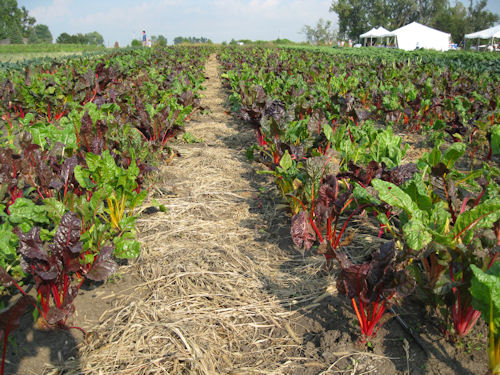Last Sunday the local paper had the first in a three-part series centered around the program Linda started at MCC. This Sunday was another above the fold front page story. There was also another article about a local food system meeting that builds on the work Linda has done.
Creating homegrown food
MCC runs crop trials, begins creating food processing facility
By LARRY KERSHNER, SPECIAL TO THE T-R
Latino restaurants and grocery stores in this county seat community prefer to make their own tortillas. But when a local supplier in Tama went out of businesses two years ago, these tiendas started looking elsewhere for their white corn supplies.
Jesus Gaytan, who owns Gaytan Tortilleria, now travels to Chicago to get his white corn and other food supplies, but said that he would prefer to buy locally, if the food was available. He needs an estimated 600 to 1,200 bushels of white corn annually.
Enter Marshalltown Community College and several other organizations determined to help Gaytan and other local businesses with fulfilling their local food needs.
“If we can do this right,” said Norm McCoy, director of the Midwest Center for Entrepreneurial Agriculture at MCC, “Locally grown white corn would give him another marketing angle for his customers.”
Among a number of other efforts, the college, under the direction of McCoy, ran a series of white corn trials, trying to determine which corn variety works best in Iowa’s cooler soils. White corn is not only a staple for tortillas, but for other dishes, such as hominy used for menudo, a Latino soup.
McCoy also supervises the certified organic food plots the college rents to community people for growing their own produce and for selling at farmers markets. He has planted nut trees and other crops for a variety of different organizations that are involved in Marshalltown’s local foods initiative.
The college is also building a certified, organic-foods processing facility, where produce can be washed and bulk packaged according to end users’ needs, McCoy said. There are plans for greenhouses in the near future.
Although all this is happening on the college campus, no college funds are directly involved, McCoy said. The trials, the gardens, the processing facility, even McCoy’s salary, are paid through grants and other outside sources.
Trials of white corn
McCoy said he volunteered to run the white corn trials for Iowa State University, in partnership with Practical Farmers of Iowa, this year. He received 19 varieties to plant in a series of four replications. His site was a high ridge that overlooks U.S. Highway 30.
But things did not go as well as he had hoped.
Spring planting was delayed. The first varieties didn’t get planted until June, because those renting private plots needed to use the program’s manual planting equipment. Rains also kept planters out of the field and when fields were dry enough, tilling created large clods that interfered with uniformed spacing of the corn.
“Sometimes the wind blew so hard,” McCoy said, “it blew the seed away as it left the planter.” Conditions were so challenging, McCoy said, he reverted to planting many of the rows by hand in order to get the crop into the ground. The last of the eight-row trial plots were planted in mid-July.
“This was a real poor year to try this,” McCoy said, adding that he hopes to get a second chance in 2010. If so, he intends to plant the trial plots in a more sheltered area on the south edge of the campus. “But I learned a lot.”
The need to find the right kind of white corn variety for local food processors is still there, he insists.
Tortillas need a minimum-sized kernel, the bigger the better, with a waxy coating that is easily removed with a lye solution. His trials were to determine yield, by variety and soil type, at varying plant populations, and recording any stalk lodging.
McCoy expects to harvest, shell and weigh the corn by hand this fall.
Unique opportunity
“We (Marshalltown) are unique to have the Latino population here,” McCoy said. “It’s hard to get them tied into the local food movement, because of communications and because they are not fully integrated into the local culture yet.”
This local food initiative has had intensive Latino interest and involvement since the early efforts to now. John Paulis, director of the Prairie Rivers Resource Conservation and Development, based in Ames, which is assisting in the overall project, said many of the immigrant population has an agrarian background and prefer to move out of the factories and packing plants and make their living on the soil.
“We want to tap into their knowledge and expertise,” McCoy said, in creating a series of local truck farms to bring human-food grade farming to the local populace.
“They have no pre-conceived ideas about farming,” McCoy said. “This is a local foods system waiting to happen.”
Incubator building
An organic foods processing facility, which is touted as a business incubator, is being built with assistance from a federal small business development grant of $250,000, and a matching grant from the Martha Ellen Tye Foundation, based in Marshall County. Of this second grant, $100,000 can be used for equipment purchases.
One limiting factor to developing a functional local foods system, McCoy said, is the lack of a “community kitchen,” where fresh produce can be washed and packaged, or be subject to value-added processes for specific end users.
Ground was broken for the facility on the campus in September. The building is expected to be available for use by late October, McCoy said.
—
Contact Larry Kershner at (515) 732-2141or at kersh@farm-news.com.
one year ago…”Homecoming 2008″




























